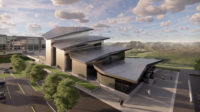University of Utah Campus Being Wired for the Future






Power outages are never welcome, no matter when they occur. But at the University of Utah, a campus that includes biomedical research facilities, a Level 1 trauma center and a cancer research hospital, power outages caused by aging infrastructure were more than an inconvenience. They also have been happening more frequently since the mid-2000s.
Established in its current location in the foothills East of Salt Lake City in 1900, the U of U campus now covers nearly 1,600 acres and includes 130 separate buildings, with 10 more under construction or slated to start in the next five years, adding to the demands of an aging infrastructure.
While money from donors and alumni keeps new buildings sprouting, the funding for a much-needed upgrade to the campus-wide electrical and high-temperature water system was harder to come by. Beginning in the early 2000s university officials made annual requests to the state legislature to fund the $99-million infrastructure upgrade but were not successful.
But in 2012, after nearly 20 years of patchwork repairs, the legislature allocated $35 million to the project and work began. In fiscal year 2013-14, a payment of $7.5 million was approved. This year (FY 2014-15), $13.5 million was authorized for improvements, along with a $35-million revenue bond issued by the university. An additional $11 million is expected in FY 2015-16.
Before funding for the new project was authorized, managers had tried to keep the system going as well as they could for as long as possible, says Scott Jefferson, project manager in the university’s Dept. of Facilities Management.
“We’d get $2.5 million a year and have to carefully fix portions of the system, but it was all driven by critical needs,” Jefferson says. “We have switches that are 40 and 50 years old, way beyond their life expectancy. They are not safe to operate.”
In addition to corroded and outdated switches, the three electrical substations serving the campus each carried different power voltages, manholes and service vaults. They were in disrepair, and pipes carrying high-pressure steam to heat the buildings were corroding and leaking.
Before one of the legislative-funding requests, the university conducted a study of the system and developed an initial plan for upgrades. When $35 million was authorized in 2012, the facilities management team turned to Salt Lake City-based Spectrum Engineers to validate and refine the initial plan.
Dave Wesemann, president and principal electrical engineer for Spectrum, says because funding beyond 2012 was not secure, the focus was not simply on replacing old equipment but also on upgrading parts of the system that would improve overall reliability.
“Because all the funding didn’t come at once, it was a challenge to prioritize things and use the funds where they were most needed for improvements,” Wesemann says. “We validated the preliminary concepts and improved upon them and established a set of standards we could follow throughout the project. The team made the big, high-level decisions up front. We used mathematical formulas to calculate the reliability increase of proposed solutions, and any that did not provide increased reliability were moved to a lower priority.”
In spring 2012, Layton Construction joined the project working under a CM/GC contract and began upgrading systems on the oldest portions of the campus. Upgrades also began at the Stadium Substation, converting it from 46 KV to 138 KV. The substation upgrade was performed in two stages with half the station taken offline and upgraded in each stage.
“We have three substations that triangulate the campus, but they provide three different voltages,” says Porter McDonough, project manager for Layton Construction. “We are getting rid of the 4160 and 7200 volts and will bring the whole campus up to 12,470 volt current. It will reduce the number of transformers needed at substations and expands the capacity and redundancy on campus.”
Wesemann says the redundancy design is one of the most unique features of the new system. “Because of the reliability requirements defined at the beginning, every building on campus has the ability to switch between two separate substations,” he says. “It is easier for maintenance to shut down substations, due to planned or unplanned events, while keeping all the buildings online.”
New trenches for concrete duct banks are being installed throughout campus and will house from two to 12 conduits, depending on the area of service. McDonough says that crews will install about 50,000 lin ft of new duct bank. Wesemann notes that spare capacity was built into the banks to handle campus growth.
“Especially in places where it was difficult to work, we built spares and feeder capacity,” says Wesemann. “We incorporated all available master plan data when we were routing duct banks to account for future buildings. We anticipate this design will accommodate the university in terms of capacity for 30-plus years.”
Aged and damaged manholes and underground vaults are also being replaced but Jefferson says that formerly below-ground transformers and switches are being moved top side.
“We are getting them out of that restricted space and putting them above ground where it is safer to work,” he says. “The switch enclosures will have brick structures around them to conceal them and make them more secure.”







